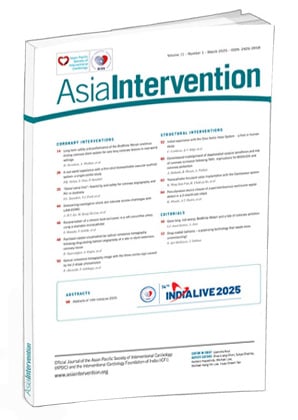Drug-eluting stents (DES) revolutionised the treatment of coronary artery disease (CAD) and have remained the standard of care for the past two decades. However, leaving a permanent metallic scaffold has been associated with late occurrence of neoatherosclerosis and thrombosis. Though bioresorbable vascular scaffolds (BVS) showed early promise, increased scaffold thrombosis resulted in the premature demise of this technology. Recently, drug-coated balloons (DCB), with their ability to provide a temporary antiproliferative effect without elevated thrombotic risk, have emerged as an attractive treatment option, leading to the “leaving nothing behind” approach12.
Optimal usage of any technology in medicine needs a thorough understanding of its mechanism of action and the mode of failure. Animal models provide an opportunity to understand the device during the preclinical stage. However, once it reaches the stage of clinical evaluation, imaging modalities play the decisive role in the appraisal of the device. In case of intracoronary implants, intravascular imaging (IVI) with intravascular ultrasound (IVUS) and optical coherence tomography (OCT), enables meticulous in vivo evaluation of the device after implantation. This is exemplified in the case of DES technology where a thorough understanding of the mode of failure of the first-generation implants led to subsequent iterations, giving birth to the contemporary DES with its excellent clinical outcomes. On the other hand, OCT observation of the intraluminal dismantling of BVS which resulted in late thrombosis led to its withdrawal.
DES scaffold the vessel, which prevents recoil and negative remodelling, and their antiproliferative effect limits neointimal hyperplasia. IVI has enlightened us on the various procedural factors that result in DES failure, such as underexpansion, geographical miss and major edge dissections. IVI-guided lesion preparation, selection of appropriate landing zones, optimal device sizing, and correction of underexpansion and major edge dissections have resulted in better outcomes compared to an angiography-guided approach. In addition, when a patient presents with DES failure, IVI helps in identifying the exact mechanism of failure and assists in pathology-directed treatment3. These improved outcomes led to the current guidelines recommending IVI for DES optimisation4.
In contrast to DES, DCB merely serves as a vehicle for drug delivery to the vessel wall. Hence, optimal lesion preparation is a prerequisite for DCB therapy. Lesion preparation is currently based on angiography, and predilatation with semicompliant or speciality balloons at a balloon-to-vessel ratio of 1:1 is recommended. Lesion preparation is considered optimal when the residual diameter stenosis is ≤30%, there is no flow-limiting dissection, and there is TIMI III flow12. IVI might provide more information on plaque morphology and true vessel size, particularly in diffuse disease, and thus help in the optimal selection of devices for lesion preparation. After lesion preparation, it allows the quantification of acute lumen gain and identification of major dissections that warrant DES implantation. In addition, IVI helps in selecting an appropriately sized DCB2.
The clinical effectiveness of DCB therapy depends on the efficient delivery of the antiproliferative drug to the vessel wall. Once delivered in sufficient concentration, the antiproliferative effect limits neointimal hyperplasia and, in addition, it also results in positive vessel remodelling and late lumen gain.
In this issue of AsiaIntervention, Vijayvergiya et al present a flashlight on the visualisation of paclitaxel crystals by OCT following DCB therapy5. Indeed, deposits of the crystalline formulations of both paclitaxel and sirolimus can be observed acutely with IVI as hyperechoic intimal deposits with shadowing, as shown elegantly in recent case studies56. In addition, follow-up imaging at one month in one of the reports demonstrated the disappearance of the majority of the particles and complete coverage of the remaining ones. In another IVUS study, late lumen enlargement was associated with both vessel enlargement and plaque regression7. Thus, IVI helps not only in vessel preparation but also in the evaluation of DCB therapy in vivo.
IVI-guided DCB therapy appears to be promising; however, current knowledge is limited: (1) very few studies have evaluated IVI for DCB procedure guidance to date, and the majority of them are retrospective; (2) there are no IVI criteria on optimal lesion preparation; (3) the various mechanisms of DCB failure are largely unknown; and (4) there are no long-term outcome data showing superiority of an IVI-guided versus an angiography-guided approach.
DCB is a novel technology. A thorough understanding and appropriate use of this technology will prevent it meeting the same fate as BVS.
Conflict of interest statement
The authors have no conflicts of interest to declare.
